Bird R.B., Stewart W.E., Lightfoot E.N. Transport Phenomena
Подождите немного. Документ загружается.

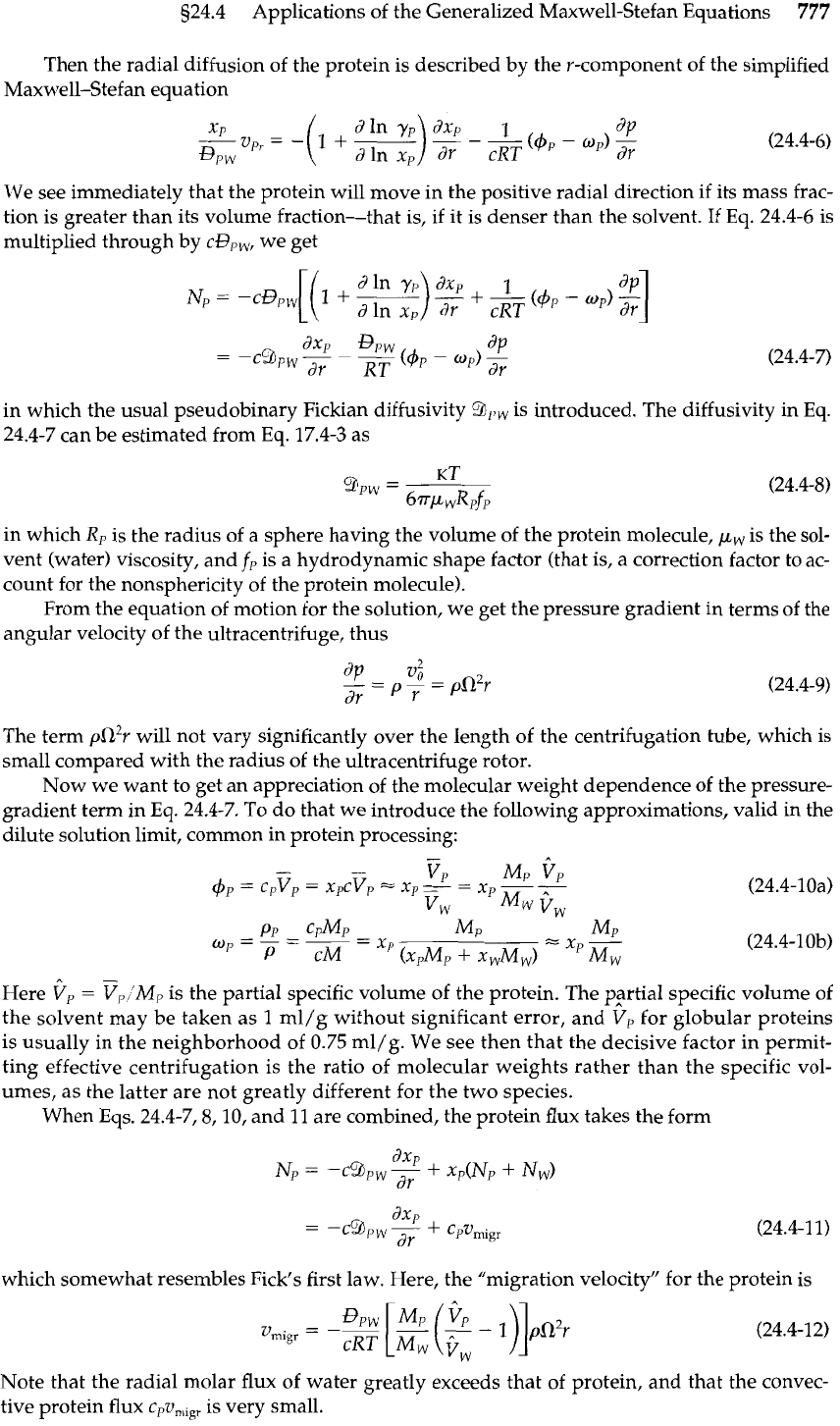
524.4 Applications of the Generalized Maxwell-Stefan Equations
777
Then the radial diffusion of the protein is described by the r-component of the simplified
Maxwell-Stefan equation
We see immediately that the protein will move in the positive radial direction if its mass frac-
tion is greater than its volume fraction-that is, if it is denser than the solvent. If Eq. 24.4-6 is
multiplied through by cB,,, we get
in which the usual pseudobinary Fickian diffusivity
9,+,,
is introduced. The diffusivity in
Eq.
24.4-7 can be estimated from
Eq.
17.4-3 as
in which Rp is the radius of a sphere having the volume of the protein molecule,
,uw
is the sol-
vent (water) viscosity, and
fp
is a hydrodynamic shape factor (that is, a correction factor to ac-
count for the nonsphericity of the protein molecule).
From the equation of motion for the solution, we get the pressure gradient in terms of the
angular velocity of the ultracentrifuge, thus
The term pf12r will not vary significantly over the length of the centrifugation tube, which is
small compared with the radius of the ultracentrifuge rotor.
Now we want to get an appreciation of the molecular weight dependence of the pressure-
gradient term in Eq. 24.4-7. To do that we introduce the following approximations, valid in the
dilute solution limit, common in protein processing:
Here
kp
=
V,/M~
is the partial specific volume of the protein. The p?rtial specific volume of
the solvent may be taken as
1
ml/g without significant error, and
V,
for globular proteins
is usually in the neighborhood of 0.75 ml/g. We see then that the decisive factor in permit-
ting effective centrifugation is the ratio of molecular weights rather than the specific vol-
umes, as the latter are not greatly different for the two species.
When Eqs. 24.4-7,8,10, and
11
are combined, the protein flux takes the form
which somewhat resembles Fick's first law. Here, the "migration velocity" for the protein is
Note that the radial molar flux of water greatly exceeds that of protein, and that the convec-
tive protein flux cpv,,,,,, is very small.
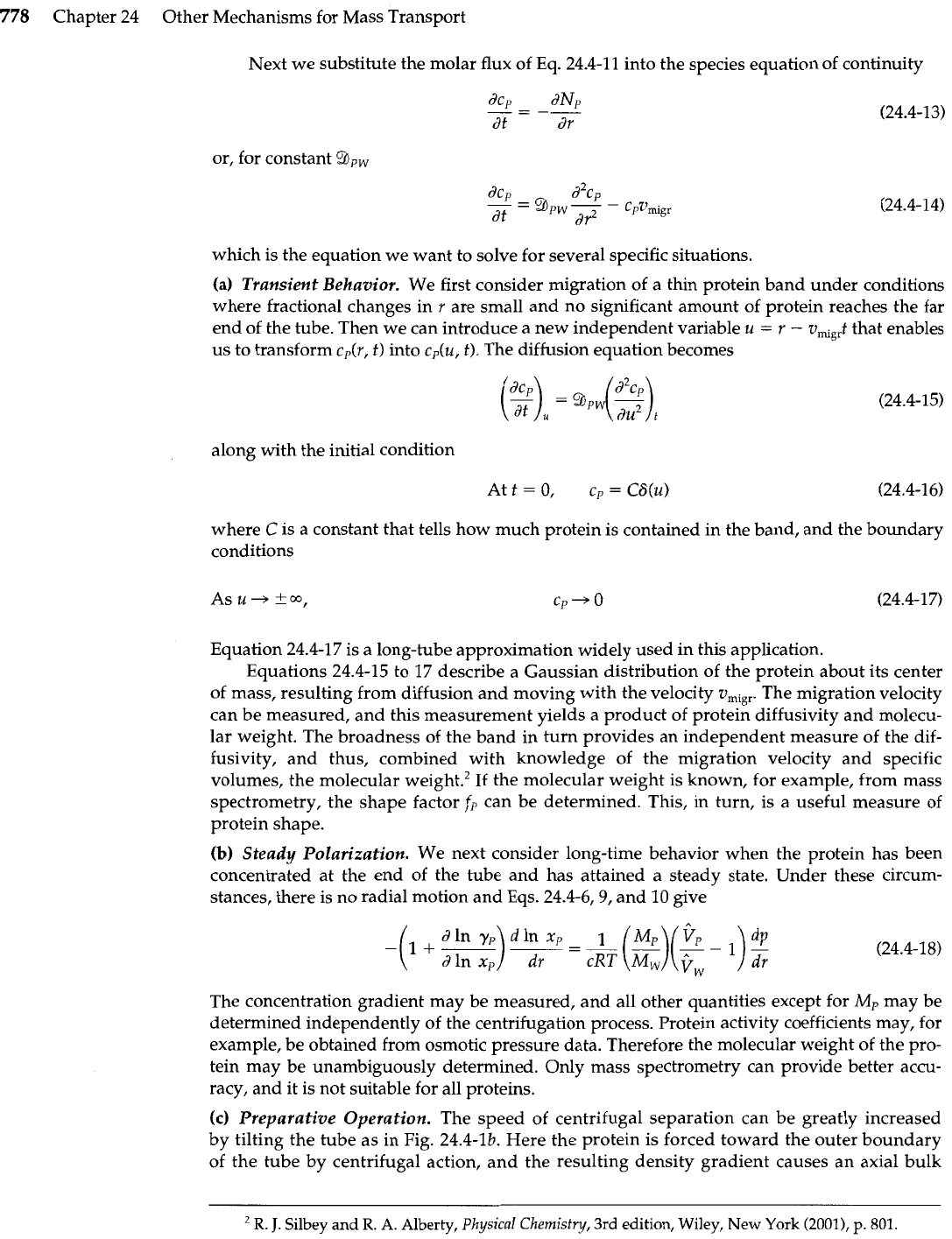
778
Chapter 24 Other Mechanisms for Mass Transport
Next we substitute the molar flux of Eq. 24.4-11 into the species equation of continuity
or, for constant
9,,
which is the equation we want to solve for several specific situations.
(a)
Transient Behavior.
We first consider migration of a thin protein band under conditions
where fractional changes in r are small and no significant amount of protein reaches the far
end of the tube. Then we can introduce a new independent variable
u
=
r
-
v,,,t
that enables
us to transform cp(r,
t)
into cp(u,
t).
The diffusion equation becomes
along with the initial condition
where
C
is a constant that tells how much protein is contained in the band, and the boundary
conditions
Equation 24.4-17 is a long-tube approximation widely used in this application.
Equations 24.4-15 to 17 describe a Gaussian distribution of the protein about its center
of mass, resulting from diffusion and moving with the velocity
vmig,.
The migration velocity
can be measured, and this measurement yields a product of protein diffusivity and molecu-
lar weight. The broadness of the band in turn provides an independent measure of the dif-
fusivity, and thus, combined with knowledge of the migration velocity and specific
volumes, the molecular weight.2 If the molecular weight is known, for example, from mass
spectrometry, the shape factor
f,
can be determined. This, in turn, is a useful measure of
protein shape.
(b)
Steady Polarization.
We next consider long-time behavior when the protein has been
concentrated at the end of the tube and has attained a steady state. Under these circum-
stances, there is no radial motion and Eqs. 24.4-6,9, and 10 give
The concentration gradient may be measured, and all other quantities except for Mp may be
determined independently of the centrifugation process. Protein activity coefficients may, for
example, be obtained from osmotic pressure data. Therefore the molecular weight of the pro-
tein may be unambiguously determined. Only mass spectrometry can provide better accu-
racy, and it is not suitable for all proteins.
(c)
Preparative Operation.
The speed of centrifugal separation can be greatly increased
by tilting the tube as in Fig. 24.4-1b.
Here
the protein is forced toward the outer boundary
of the tube by centrifugal action, and the resulting density gradient causes an axial bulk
R.
J.
Silbey
and
R.
A. Alberty,
Physical Chemisty,
3rd edition, Wiley, New York
(2001),
p.
801.
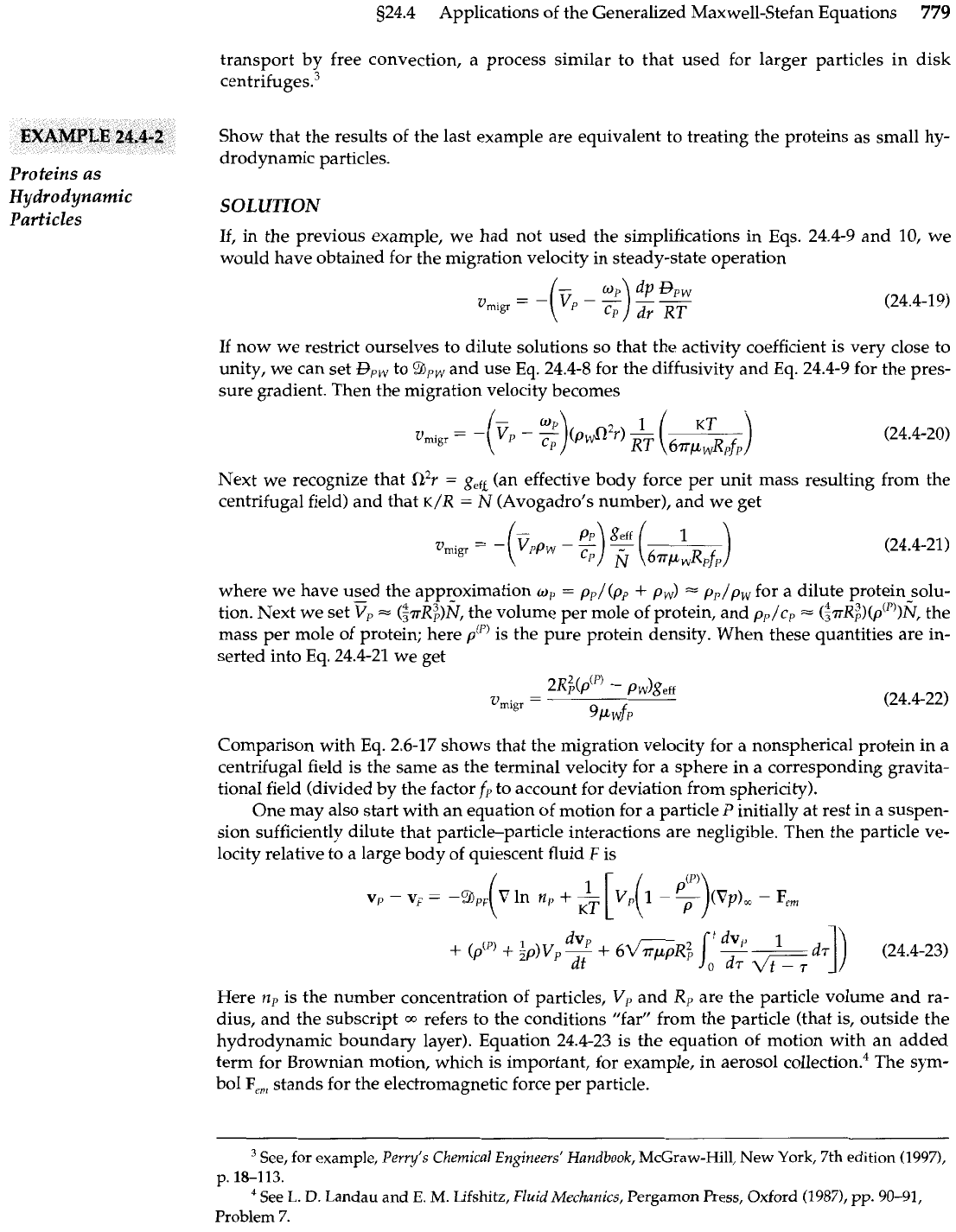
924.4 Applications of the Generalized Maxwell-Stefan Equations
779
transport by free convection, a process similar to that used for larger particles in disk
centrifuge^.^
Show that the results of the last example are equivalent to treating the proteins as small hy-
drodynamic particles.
Proteins as
Hydrodynamic
SOLUTION
Particles
If, in the previous example, we had not used the simplifications in Eqs. 24.4-9 and
10,
we
would have obtained for the migration velocity in steady-state operation
If now we restrict ourselves to dilute solutions so that the activity coefficient is very close to
unity, we can set
Bp,,
to
9,,
and use Eq. 24.4-8 for the diffusivity and
Eq.
24.4-9 for the pres-
sure gradient. Then the migration velocity becomes
Next we recognize that
L12r
=
gey
(an effective body force per unit mass resulting from the
centrifugal field) and that
K/
R
=
N (Avogadro's number), and we get
where we have used the approximation
w,
=
pp/(pp
+
pw)
=
pp/pw for a dilute protein_solu-
tion. Next we set
kp
=
($TR$?,
the volume per mole of protein, and pp/cP
=
($.rr~;)(p(~))N, the
mass per mole of protein; here
p'P'
is the pure protein density. When these quantities are in-
serted into
Eq.
24.4-21 we get
Comparison with Eq. 2.6-17 shows that the migration velocity for a nonspherical protein in a
centrifugal field is the same as the terminal velocity for a sphere in a corresponding gravita-
tionaI field (divided by the factor
fp
to account for deviation from sphericity).
One may also start with an equation of motion for a particle
P
initially at rest in a suspen-
sion sufficiently dilute that particle-particle interactions are negligible. Then the particle ve-
locity relative to a large body of quiescent fluid
F
is
Here
n,
is the number concentration of particles,
V,
and R, are the particle volume and ra-
dius, and the subscript
m
refers to the conditions "far" from the particle (that is, outside the
hydrodynamic boundary layer). Equation 24.4-23 is the equation of motion with an added
term for Brownian motion, which is important, for example, in aerosol c~llection.~ The sym-
bol
F,,
stands for the electromagnetic force per particle.
See, for example,
Perry's Chemical Engineers' Handbook,
McGraw-Hill,
New
York, 7th edition (1997),
p.
18-113.
See
L.
D.
Landau and
E.
M.
Lifshitz,
Fluid
Mechanics,
Pergamon Press, Oxford (1987),
pp.
90-91,
Problem 7.
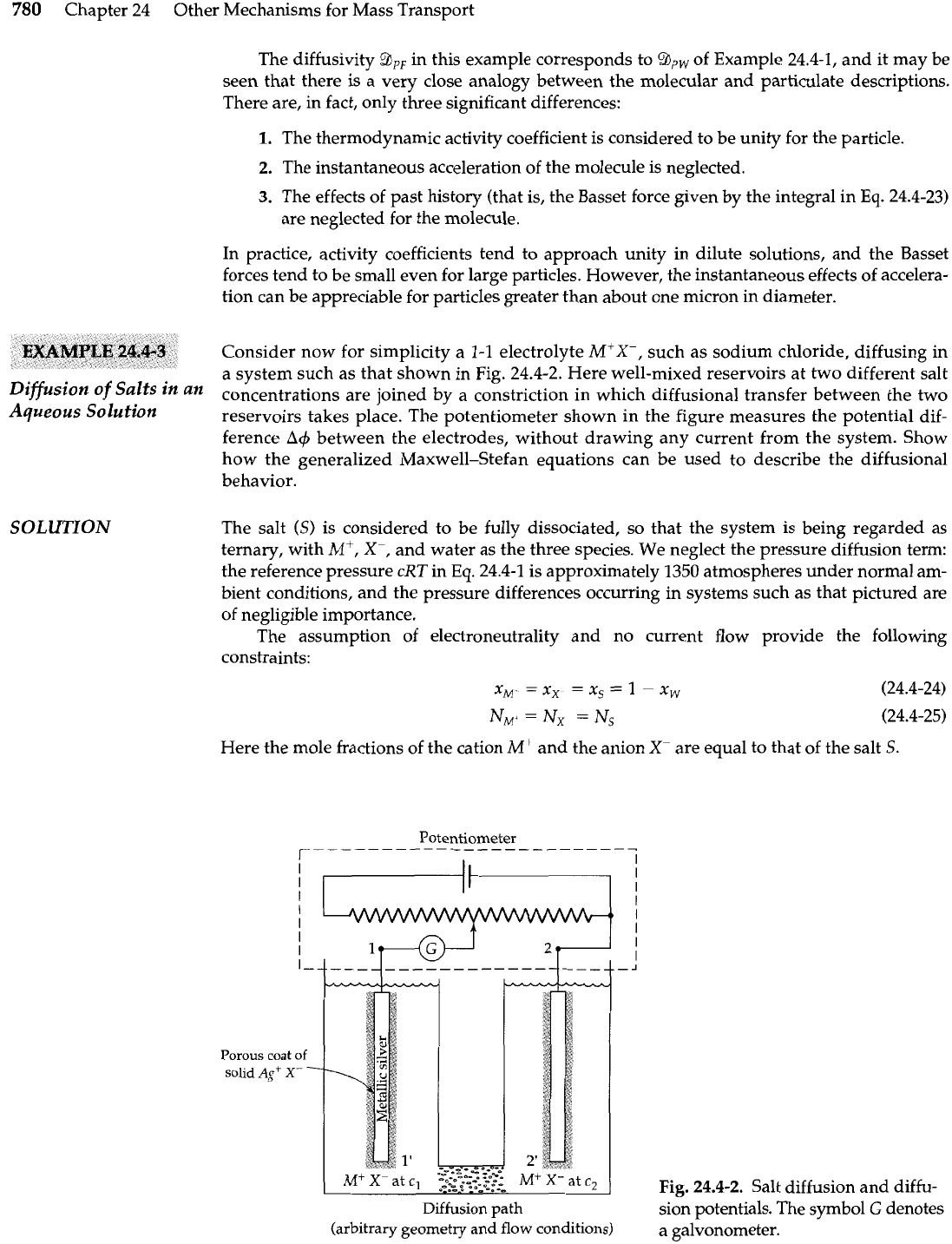
780
Chapter 24 Other Mechanisms for Mass Transport
EXAMPLE
24.4-3
Diffusion of Salts in an
Aqueous Solution
SOLUTION
The diffusivity
9,,
in this example corresponds to
9,,
of Example 24.4-1, and it may
be
seen that there is
a
very close analogy between the molecular and particulate descriptions.
There are, in fact, only three significant differences:
1.
The thermodynamic activity coefficient is considered to be unity for the particle.
2.
The instantaneous acceleration of the molecule is neglected.
3.
The effects of past history (that is, the Basset force given by the integral in
Eq.
24.4-23)
are neglected for the molecule.
In practice, activity coefficients tend to approach unity in dilute solutions, and the Basset
forces tend to be small even for large particles. However, the instantaneous effects of accelera-
tion can be appreciable for particles greater than about one micron in diameter.
Consider now for simplicity a 1-1 electrolyte
M'X-,
such as sodium chloride, diffusing in
a system such as that shown in Fig. 24.4-2. Here well-mixed reservoirs at two different salt
concentrations are joined by a constriction in which diffusional transfer between the two
reservoirs takes place. The potentiometer shown in the figure measures the potential dif-
ference
A+
between the electrodes, without drawing any current from the system. Show
how the generalized Maxwell-Stefan equations can be used to describe the diffusional
behavior.
The salt
(S)
is considered to be fully dissociated, so that the system is being regarded as
ternary, with
Mi,
Xp, and water as the three species.
We
neglect the pressure diffusion term:
the reference pressure
cRT
in
Eq.
24.4-1 is approximately 1350 atmospheres under normal am-
bient conditions, and the pressure differences occurring in systems such as that pictured are
of negligible importance.
The assumption of electroneutrality and no current flow provide the following
constraints:
XM-
=
xx
=
xS
=
1
xw
(24.4-24)
NM+
=
Nx
=
Ns
(24.4-25)
Here the mole fractions of the cation
M
'
and the anion X are equal to that of the salt
S.
I
I
I
I
I
I
I
I
-A
Fig.
24.4-2.
Salt diffusion and diffu-
Diffusion path
siin potentials. The symbol
G
denotes
(arbitrary
geometry
and flow conditions)
a
galvanometer.
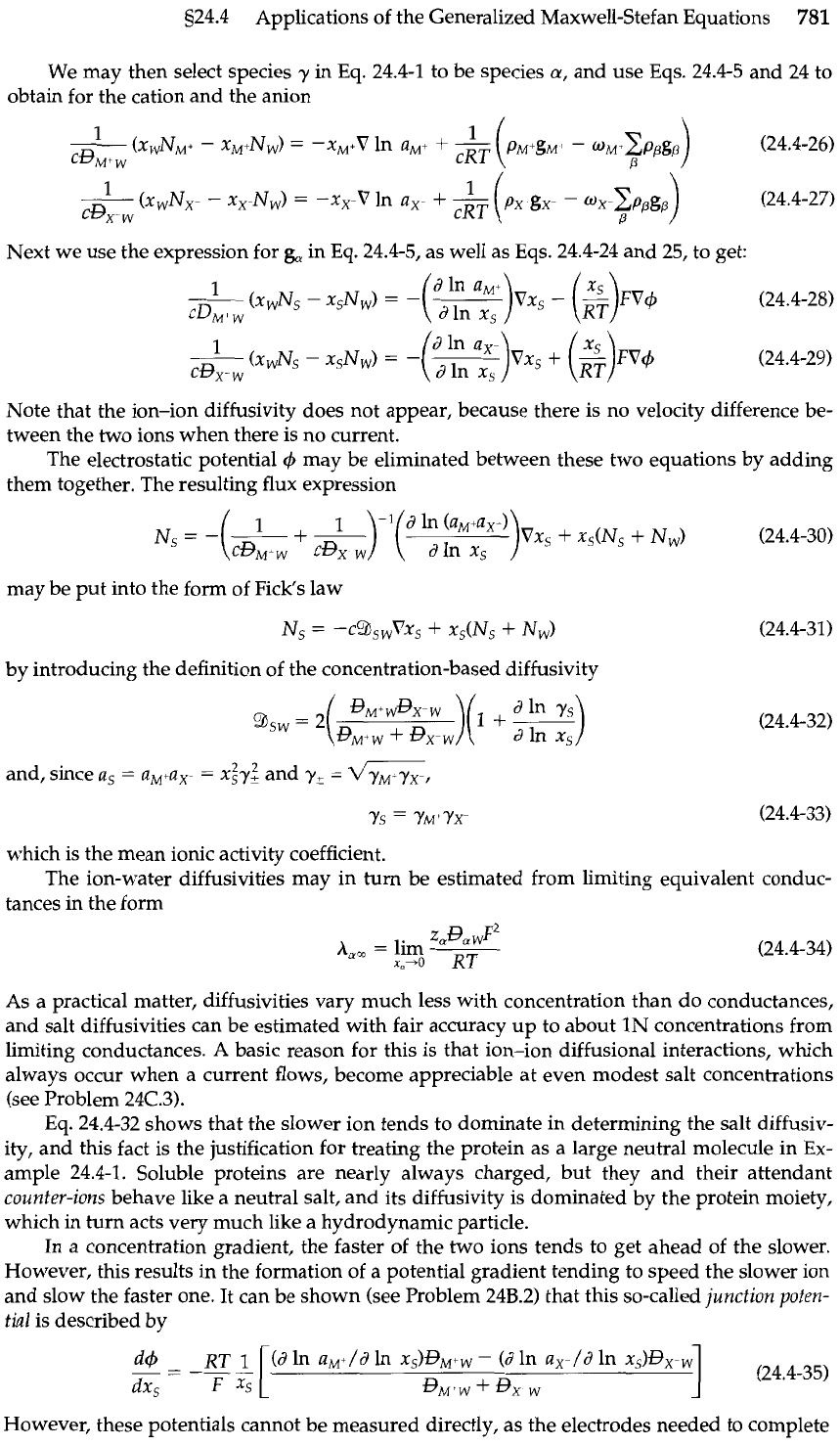
g24.4 Applications of the Generalized Maxwell-Stefan Equations
781
We may then select species
y
in Eq. 24.4-1 to be species
a,
and use Eqs. 24.4-5 and 24 to
obtain for the cation and the anion
Next we use the expression for
g,
in Eq. 24.4-5, as well as Eqs. 24.4-24 and 25, to get:
Note that the ion-ion diffusivity does not appear, because there is no velocity difference be-
tween the two ions when there is no current.
The electrostatic potential
4
may be eliminated between these two equations by adding
them together. The resulting flux expression
may be put into the form of Fick's law
by introducing the definition of the concentration-based diffusivity
and, since
as
=
aM+ax
=
and
y2
=
G,
which is the mean ionic activity coefficient.
The ion-water diffusivities may in turn be estimated from limiting equivalent conduc-
tances in the form
A,,
=
lim
z,B,
wF2
x,-o
RT
As a practical matter, diffusivities vary much less with concentration than do conductances,
and salt diffusivities can be estimated with fair accuracy up to about IN concentrations from
limiting conductances. A basic reason for this is that ion-ion diffusional interactions, which
always occur when a current flows, become appreciable at even modest salt concentrations
(see Problem 24C.3).
Eq. 24.4-32 shows that the slower ion tends to dominate in determining the salt diffusiv-
ity, and this fact is the justification for treating the protein as a large neutral molecule in
Ex-
ample 24.4-1. Soluble proteins are nearly always charged, but they and their attendant
counter-ions
behave like a neutral salt, and its diffusivity is dominated by the protein moiety,
which in turn acts very much like a hydrodynamic particle.
In
a concentration gradient, the faster of the two ions tends to get ahead of the slower.
However, this results in the formation of a potential gradient tending to speed the slower ion
and slow the faster one. It can be shown (see Problem 24B.2) that this so-called
junction
poten-
tial
is described by
However, these potentials cannot be measured directly, as the electrodes needed to complete

782
Chapter 24 Other Mechanisms for Mass Transport
However, these potentials cannot be measured directly, as the electrodes needed to complete
the electric circuit affect the measurement (see Problem 24C.3). One can obtain an approxi-
mate value through the use of potassium chloride salt
bridge^.^
This
elementary example is only a very bare introduction to a complex and impor-
tant subject. The interested reader is referred to the large literature on electr~chemistry.~
EXAMPLE
24.4-4
Departures from Local
ElectroneutraZity:
~lectro-Osmosis6
It is already clear from the preceding discussion of diffusion potential that local departures
from electroneutrality do exist in diffusing electrolytes, and they are not always negligible.
To
examine this situation, consider a long tube of circular cross section containing an electrolyte,
at least one component of which is adsorbed on the tube wall. This adsorption results in a
fixed surface charge and a region of net charge, the diffuse double layer, in the solution adjacent
to the tube wall. This net charge will produce an electric field within the tube that varies with
radial, but not axial, position. If a potential difference is applied across the ends of the tube,
the result will be a fluid flow, known as electro-osmosis. Conversely, if a hydrodynamic pres-
sure is used to produce a flow, it will result in a potential difference, known as a streaming po-
tential, developing across the ends of the tube. These phenomena are representative of a class
known as electrokinetic phenomena. Develop an expression for the electro-osmotic flow de-
veloped in the absence of an axial pressure gradient.
SOLUTION
Our first problem is now to develop an expression for the electrostatic potential distribution,
after which we can calculate the electro-osmotic flow.
The starting point for the electrostatic potential calculation is the Poisson equation
Here
p,
is the electrical charge density
and
E
is the dielectric permittivity of the solution. For the problem at hand,
Eq.
24.4-36 re-
duces to
Now, following Newman6 we assume that the concentration of charge follows a Boltzmann
distribution
and use a truncated Taylor expansion, known as the Debye-Hiickel approximation, so that
we can obtain an explicit solution. Here the subscript
w
can be considered to indicate the cen-
terline of the tube, because, as we shall see, the charge density drops off very rapidly with the
distance from the tube wall. For the same reason we may neglect the wall curvature and as-
sume that the net charge at the centerline is zero so that
d2'$
-
4
F2
-1/2
where
h
=
dy2
h2
R.
A.
Robinson and
R.
H. Stokes,
Electrolyte Solutions,
revised edition, Butterworth, London (19651,
p. 571. This venerable reference contains a great detail of useful data.
See, for example,
J.
S.
Newman,
Electrochemical Systems,
2nd edition, Prentice-Hall, Englewood
Cliffs,
N.J.
(1991). Example 24.4-4 is taken
from
p. 215.
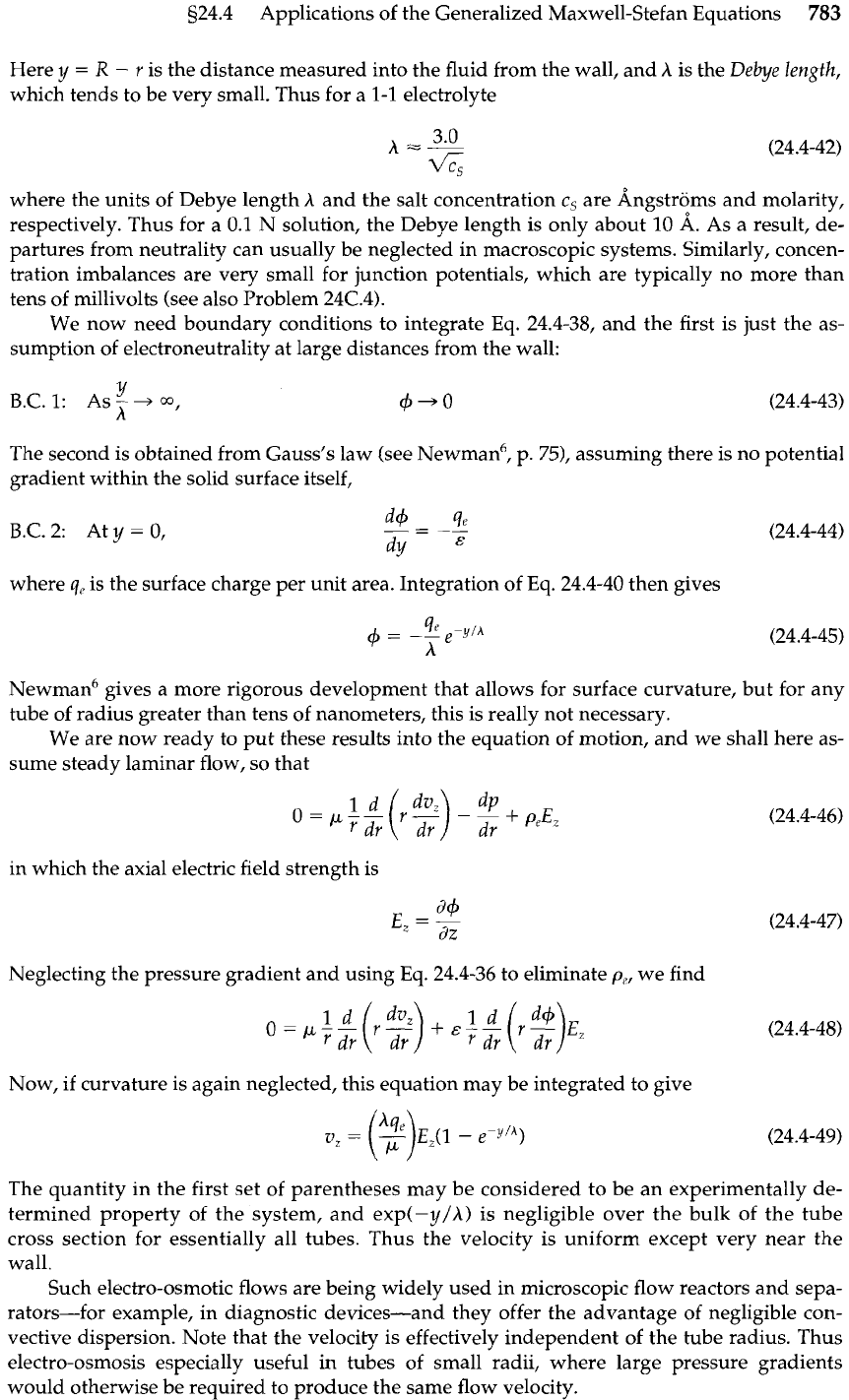
s24.4 Applications of the Generalized Maxwell-Stefan Equations
783
Here
y
=
R
-
r
is the distance measured into the fluid from the wall, and h is the Debye length,
which tends to be very small. Thus for a 1-1 electrolyte
where the units of Debye length h and the salt concentration
cs
are Angstroms and molarity,
respectively. Thus for a 0.1 N solution, the Debye length is only about
10
A.
As a result, de-
partures from neutrality can usually be neglected in macroscopic systems. Similarly, concen-
tration imbalances are very small for junction potentials, which are typically no more than
tens of millivolts (see also Problem 24C.4).
We now need boundary conditions to integrate Eq. 24.4-38, and the first is just the as-
sumption of electroneutrality at large distances from the wall:
Y
B.C.
1:
AS
-
+
a,
4-0 (24.4-43)
h
The second is obtained from Gauss's law (see ~ewman',
p.
75),
assuming there is no potential
gradient within the solid surface itself,
B.C. 2: At
y
=
0,
where
q,
is the surface charge per unit area. Integration of Eq. 24.4-40 then gives
Newman6 gives a more rigorous development that allows for surface curvature, but for any
tube of radius greater than tens of nanometers, this is really not necessary.
We are now ready to put these results into the equation of motion, and we shall here as-
sume steady laminar flow, so that
in which the axial electric field strength is
Neglecting the pressure gradient and using Eq. 24.4-36 to eliminate p,, we find
Now, if curvature is again neglected, this equation may be integrated to give
The quantity in the first set of parentheses may be considered to be an experimentally de-
termined property of the system, and exp(-y/h) is negligible over the bulk of the tube
cross section for essentially all tubes. Thus the velocity is uniform except very near the
wall.
Such electro-osmotic flows are being widely used in microscopic flow reactors and sepa-
rators-for example, in diagnostic devices-and they offer the advantage of negligible con-
vective dispersion. Note that the velocity is effectively independent of the tube radius. Thus
electro-osmosis especially useful in tubes of small radii, where large pressure gradients
would otherwise be required to produce the same flow velocity.

784
Chapter 24 Other Mechanisms for Mass Transport
EXAMPLE
24.4-5
Additional Mass
Transfer Driving Forces
We have now covered all of the mass transfer mechanisms normally considered in a nonequi-
librium thermodynamic framework, but there are other possibilities that have proven signifi-
cant. Here we consider three: the force on a charged particle moving across a magnetic field,
and the forces of electrical or magnetic induction. These contain nonlinear terms-that is,
products of species velocities and force fields-and therefore they are, strictly speaking, out-
side the scope of irreversible thermodynamics. However, it has been found permissible to
add them to the body forces appearing in Eq. 24.4-1. Develop a specific form for the resulting
equation, and show how it can be used to describe mass transfer processes affected by one or
more of these additional forces.
SOLUTION
We begin by defining an extended driving force for mass transfer,
d,,,,
to include these addi-
tional forces:
Here
B
is the magnetic induction, E
=
VI$
the electric field,
Ti'
the electric susceptibility, and
l7,"""he
magnefic
susceptibility.
The origin of the terms containing [v,
X
B]
and
[E
VEI in Eq. 24.4-50 is in the Lorentz
relation
where
qo
is the electric charge. This is shown explicitly in Eq. 24.4-51 for a charged particle
moving through a magnetic field (see Problem 24B.1), but only indirectly for the electric in-
duction [E
.
VE], which is based on the interaction of a nonuniform
field
with an electric dipole.
To show the origin of the [E
.
VEI term in
Eq.
24.4-50, consider, for example, the one-
dimensional situation pictured in Fig. 24.4-3. An electric field will tend to align dipoles that
are normally randomized by Brownian motion, and, if the field is nonuniform, there will be
a
net force on an aligned dipole of magnitude
where
qo
is the magnitude of the charge at either end of the dipole and
1
is the distance be-
tween the two centers of charge.
In some cases-for example, the zwitterion form of amino acids-one can determine
both
q0
and
I
from molecular theory. However, for particles and most molecules, one finds
only induced dipoles: a partial charge separation resulting from the presence of the field. Under
the conditions of interest here, only a small fraction of intrinsic dipoles is aligned with the
field, and both the fractional alignment of these and the strength of the induced dipoles are
Unaligned dipoles
(in absence
of
an electric field)
W
P
.9
YI
u
.r(
&
E=Eo
A
W
z
=
0
Fig.
24.4-3.
Origin of the dielectro-
Position,
z
phoretic force given in
Eq.
24.4-52.
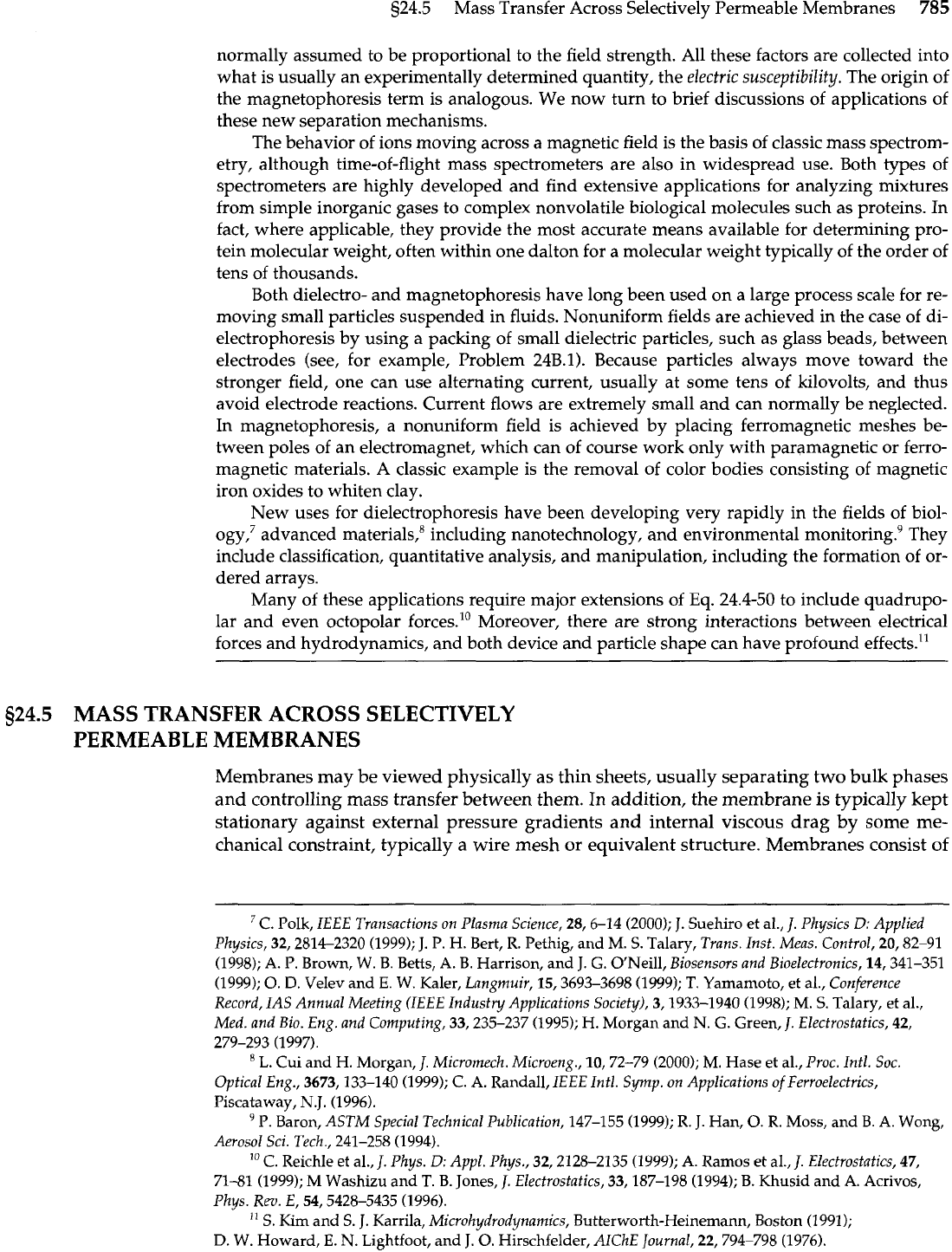
g24.5 Mass Transfer Across Selectively Permeable Membranes
785
normally assumed to be proportional to the field strength. All these factors are collected into
what is usually an experimentally determined quantity, the
electric susceptibility.
The origin of
the magnetophoresis term is analogous. We now turn to brief discussions of applications of
these new separation mechanisms.
The behavior of ions moving across a magnetic field is the basis of classic mass spectrom-
etry, although time-of-flight mass spectrometers are also in widespread use. Both types of
spectrometers are highly developed and find extensive applications for analyzing mixtures
from simple inorganic gases to complex nonvolatile biological molecules such as proteins. In
fact, where applicable, they provide the most accurate means available for determining pro-
tein molecular weight, often within one dalton for a molecular weight typically of the order of
tens of thousands.
Both dielectro- and magnetophoresis have long been used on a large process scale for re-
moving small particles suspended in fluids. Nonuniform fields are achieved in the case of di-
electrophoresis by using
a
packing of small dielectric particles, such as glass beads, between
electrodes (see, for example, Problem 24B.1). Because particles always move toward the
stronger field, one can use alternating current, usually at some tens of kilovolts, and thus
avoid electrode reactions. Current flows are extremely small and can normally be neglected.
In magnetophoresis, a nonuniform field is achieved by placing ferromagnetic meshes be-
tween poles of an electromagnet, which can of course work only with paramagnetic or ferro-
magnetic materials. A classic example is the removal of color bodies consisting of magnetic
iron oxides to whiten clay.
New uses for dielectrophoresis have been developing very rapidly in the fields of biol-
~gy,~ advanced materials: including nanotechnology, and environmental monitoring? They
include classification, quantitative analysis, and manipulation, including the formation of or-
dered arrays.
Many of these applications require major extensions of
Eq.
24.4-50 to include quadrupo-
lar and even octopolar forces.1° Moreover, there are strong interactions between electrical
forces and hydrodynamics, and both device and particle shape can have profound effects."
524.5
MASS TRANSFER ACROSS SELECTIVELY
PERMEABLE MEMBRANES
Membranes may be viewed physically as thin sheets, usually separating two bulk phases
and controlling mass transfer between them.
In
addition, the membrane is typically kept
stationary against external pressure gradients and internal viscous drag by some me-
chanical constraint, typically a wire mesh or equivalent structure. Membranes consist of
C.
Polk,
IEEE Transactions on Plasma Science,
28,6-14 (2000);
J.
Suehiro et al.,
1.
Physics
D:
Applied
Physics,
32,2814-2320 (1999);
J.
P.
H. Bert, R. Pethig, and
M.
S.
Talary,
Trans. Inst. Meas. Control,
20,82-91
(1998);
A.
P.
Brown, W. B. Betts, A. B. Harrison, and
J.
G.
O'Neill,
Biosensors and Bioelectronics,
14,341-351
(1999);
0.
D.
Velev and
E.
W.
Kaler,
Langmuir,
15,3693-3698 (1999);
T.
Yamamoto, et al.,
Conference
Record, IAS Annual Meeting (IEEE Industry Applications Society),
3,1933-1940 (1998);
M.
S.
Talary, et al.,
Med. and Bio. Eng. and Computing,
33,235-237 (1995);
H.
Morgan and N.
G.
Green,
J.
Electrostafics,
42,
279-293 (1997).
L.
Cui and H. Morgan,
J.
Micromech. Microeng.,
10,72-79 (2000);
M.
Hase et al.,
Proc. Intl. Soc.
Optical Eng.,
3673,133-140 (1999);
C. A. Randall,
IEEE Intl. Symp. on Applications of Ferroelectrics,
Piscataway,
N.J.
(1996).
P,
Baron,
ASTM Special Technical Publication,
147-155 (1999);
R.
J. Han,
0.
R.
Moss, and
B.
A.
Wong,
Aerosol Sci. Tech.,
241-258 (1994).
''
C.
Reichle et al.,
J.
Phys.
D:
Appl. Phys.,
32,2128-2135 (1999);
A.
Ramos et al.,
J.
Electrostatics,
47,
71-81 (1999);
M
Washizu and
T.
B. Jones,
J.
Electrostatics,
33,187-198 (1994);
8.
Khusid and A. Acrivos,
Phys. Rev. E,
54,5428-5435 (1996).
"
S.
Kim and
S.
J. Karrila,
Microhydrodynamics,
Butterworth-Heinemann, Boston
(1
991);
D.
W. Howard,
E.
N.
Lightfoot, and
J.
0.
Hirschfelder,
AIChE Journal,
22,794-798 (1976).
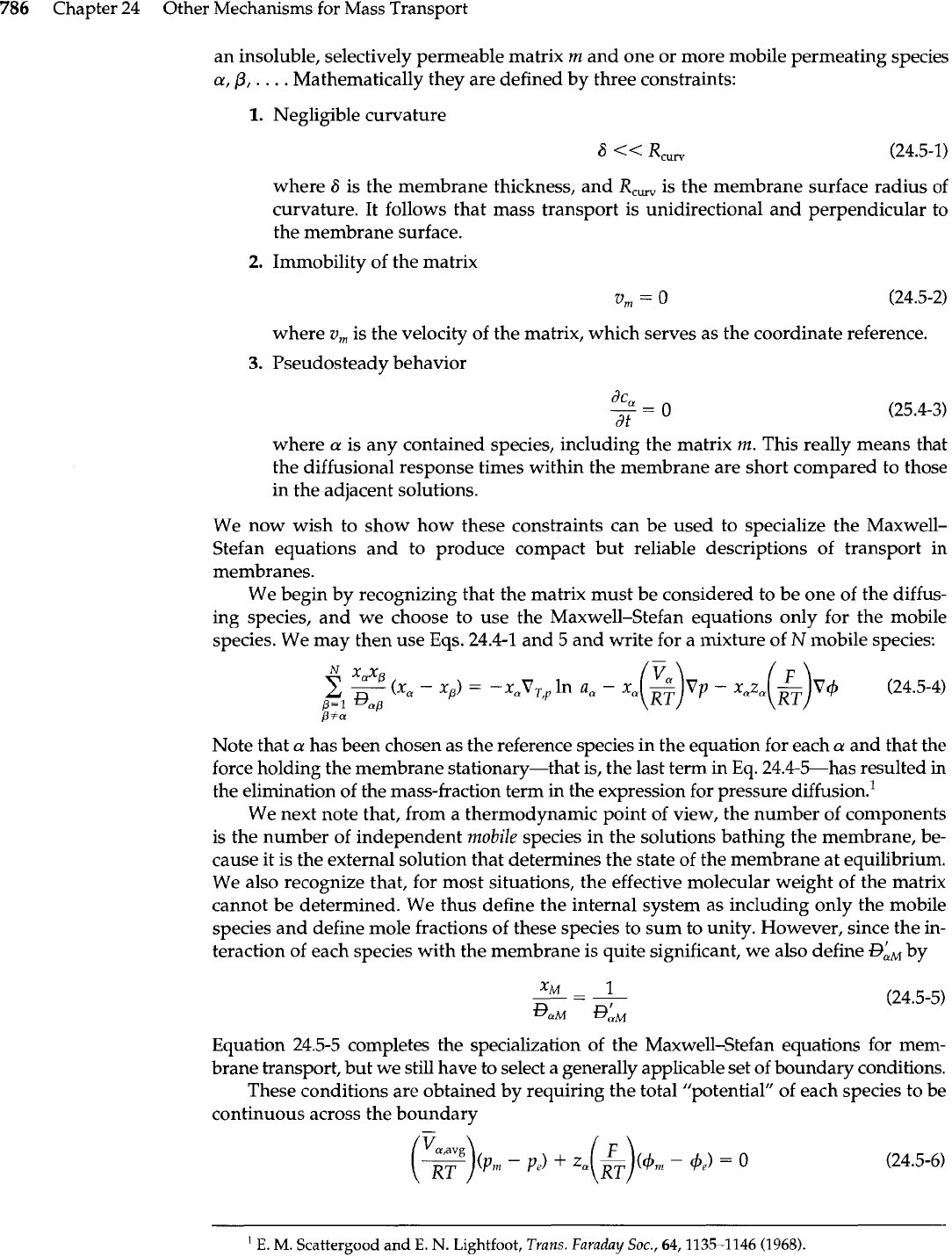
786
Chapter
24
Other Mechanisms for Mass Transport
an insoluble, selectively permeable matrix
rn
and one or more mobile permeating species
a,
Pf
.
. . .
Mathematically they are defined by three constraints:
1.
Negligible curvature
where
6
is the membrane thickness, and
R,,,,
is the membrane surface radius
of
curvature. It follows that mass transport is unidirectional and perpendicular
to
the membrane surface.
2.
Immobility of the matrix
where
v,
is the velocity of the matrix, which serves as the coordinate reference.
3.
Pseudosteady behavior
where
a
is any contained species, including the matrix
m.
This really means that
the diffusional response times within the membrane are short compared to those
in the adjacent solutions.
We now wish to show how these constraints can be used to specialize the Maxwell-
Stefan equations and to produce compact but reliable descriptions of transport in
membranes.
We begin by recognizing that the matrix must be considered to be one of the diffus-
ing species, and we choose to use the Maxwell-Stefan equations only for the mobile
species. We may then use Eqs. 24.4-1 and
5
and write for a mixture of
N
mobile species:
Note that
cr
has been chosen as the reference species in the equation for each
a
and that the
force holding the membrane stationary-that is, the last term in Eq. 24.4-5-has resulted in
the elimination of the mass-fraction term in the expression for pressure diffusion.'
We next note that, from a thermodynamic point of view, the number of components
is the number of independent
mobile
species in the solutions bathing the membrane, be-
cause it is the external solution that determines the state of the membrane at equilibrium.
We also recognize that, for most situations, the effective molecular weight of the matrix
cannot be determined. We thus define the internal system as including only the mobile
species and define mole fractions of these species to sum to unity. However, since the in-
teraction of each species with the membrane is quite significant, we also define
BLM
by
Equation 24.5-5 completes the specialization of the Maxwell-Stefan equations for mem-
brane transport, but we still have to select a generally applicable set of boundary conditions.
These conditions are obtained by requiring the total "potential" of each species to be
continuous across the boundary
E.
M.
Scattergood and
E.
N.
Lightfoot,
Trans.
Faraday
Soc.,
64,1135-1146
(1968).
